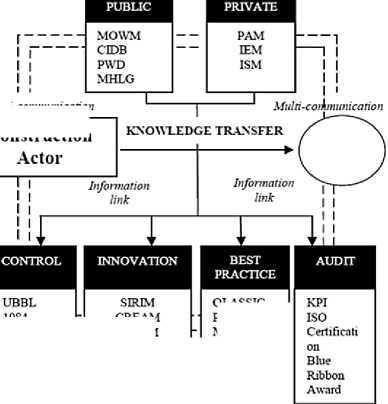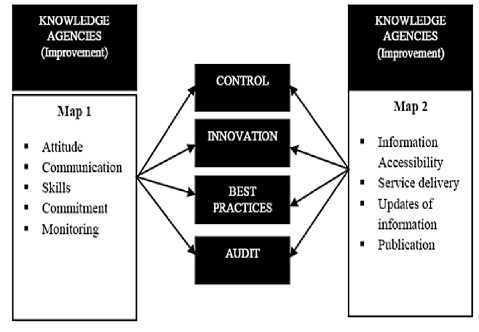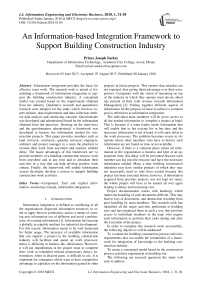An information-based integration framework to support building construction industry
Автор: Prince Joseph Sackey
Журнал: International Journal of Information Engineering and Electronic Business @ijieeb
Статья в выпуске: 1 vol.10, 2018 года.
Бесплатный доступ
Information integration provides the basis for effective team work. The research work is aimed at for-mulating a framework of information integration to sup-port the building construction industry. A conceptual model was created based on the requirements obtained from the industry. Qualitative research and quantitative research were adopted for the study which involves ex-pert opinion, data requirements and data collection method, data analysis and sensitizing concepts. Questionnaire was developed and administered based on the information obtained from the interview. Drawing on the interviews and the questionnaires administered, a framework was developed to harness the information needed for construction projects. This paper provides members such as land surveyor, contractor, quantity surveyor, engineers, architect and project manager in a team the platform to execute their work from anywhere and anytime without delay. The major advantages of this framework are: to provide members of a building construction team to work from anywhere and at any time and to articulate their activities in a way that can help develop positive work culture. Finally, the framework will enable information system developer develop a system to support building construction work activities.
Component, Tacit and explicit infor-mation, sensitizing concept, information integration
Короткий адрес: https://sciup.org/15016120
IDR: 15016120 | DOI: 10.5815/ijieeb.2018.01.05
Текст научной статьи An information-based integration framework to support building construction industry
Published Online January 2018 in MECS
Information integration is defined as combining of all the organizations dispersed information resources in order to apply them in production, and as a means of creating new information out of different and novel combinations of existing information [1]. Information has become a globally acceptable medium for industrial development. For this reason, Information needs to be well harnessed for better usage. The presence of available information that can support a project in the building construction industry will facilitate and speed up work processes; hence is difficulty to harness this information. However, it will put impediments in the project team to complete their work as scheduled without unnecessary delays. Information, when in discrete parts, is difficult to use. It is important for companies which want to have competitive advantage to capitalize on the information gained in other projects in future projects. This ensures that mistakes are not repeated, thus giving them advantage over their competitors. Companies with the vision of remaining on top of the industry in which they operate must devote about one percent of their total revenue towards Information Management [2]. Putting together different aspects of information for the purpose of reuse to achieve a common goal is referred to as information integration.
The individual team members will be given access to all the needed information to complete a project at hand. This is because if a team leader needs information that will enable him or her execute his or her duty and the necessary information is not at hand, it will cause delay in the work processes. The problem becomes severe in situations where other members who have to deliver such information are not found on time or not available.
However, if there is a common place where all information in the organization is harness and kept at an appropriate time, this delay will be prevented because each member can log into the resource and have the necessary information needed. Many a time building construction industries may have similar projects of which they may not necessarily need to start from scratch because this project has been executed before; however, if information acquired from previous projects was not kept for reuse, the whole project will have to be started all over again leading to delays and increasing cost.
Project documentation comes with hardcopy which makes the handling of such documents difficult. This may lead to loss of documents, and destruction resulting from poor handling by team members. The research work has identified all the major activities performed at building sites and has organized them in such a way that provides access to individual members in the team who require such information to perform their tasks during and after the execution of the project.
In order to complete this research work successfully, the following objectives will be addressed:
To evaluate the building construction process activities requirements that can enable the formulation of a framework for integration of knowledge in the building construction industry.
To create a conceptual model based on the construction process activities requirement on building site.
The following are research questions the study will seek to address:
What information is required from team members of a building construction to execute a building construction project?
How will these team members fit into a model to integrate the information from each member?
II. Related Work
-
A. Information Integration
Fig. 1 is a transmission of information framework for the construction industry in Malaysia. The information transmission in this framework lay emphasis on transmission of information from the outside agencies to team member in a construction firm [3]. Its concentration was not on the information that is supposed to be shared among team members to complete a project but maintaining the Integrity of the Specifications. To make the first model in Fig. 1 properly integrate information, [3] introduced an elementary tactic of mapping transmission of information as shown in Fig. 2.
In view of these frameworks discussed, none these frameworks considered the integration of information based on disciplines and among team members within a project in the building construction industry. This paper sought to harness the knowledge based on major disciplines for building projects in the building construction industry from the design stages of the project to the completion.
-
B. Tacit and Explicit Information
Information which is tacit is difficult to validate and extremely personal. Understanding of individuals, guesses and perceptions is categorized under this type of information. Such information is soft and keeps in the head [4]. Tacit information is tougher to handover [1], [4] besides it forms from communal understanding [5]. An instance of tacit information is the difficulty in illustrating how to travel with an air craft prior to its use.

CREAM IK RAM
ACT 133
ACT 176
QLASS1C PP MCEIA
Fig.1. Transmission of Information (FK) Framework
Multi-communication
Construction
Information which is explicit may be communicated in numbers or words. This will provide the information in codified processes and hard data form.

Fig.2. Information map strategy
Explicit information is independent and impersonal of the context and is also described as object and rule base [6]. Hence, explicit information can be developed by formal learning, attained without influence from the information owner, and can be deposited in one location [5].
-
C. Information used in Building Construction Project
The construction process information needs should be extracted from all stakeholders in the building industry and should be duly integrated effectively [7]. Commendable construction information integration with various phases of project development might overcome these challenges which could impede success in project execution [8].
Список литературы An information-based integration framework to support building construction industry
- Grant, R. M, "Toward a Knowledge-Based Theory of the Firm." Strategic Management Journal 17(Winter Special Issue):, 1996, pp.109-122.
- Bullen, D, Corporate Training & Development: How Top Companies Make The ROI Case For Employee Training. NY: Apollo light speed, 2014. Accessed from https://mitpress.mit.edu/sites/ default/.../9780262015080_ sch_0001.pdf on 4/11/2015
- Moh’d A. Z and Hilary, D, Knowledge transfer: A model framework for construction knowledge integration. Con-ference Papers. Paper 20. Geelong: Bond University ePublications@bond, 2011, Access from http://epublications.bond.edu.au/cgi/viewcontent. cgi?article=1019&context=aubea_2011 on 23/10/2016
- Ruppel, C., Harrington, S, Sharing Knowledge Through Intranets: A Study of Organisational Culture and Intranet Implementation. IEEE Transactions on Professional Communication, 2001, vol. 44, issue 1, pp.37-52.
- Lam, A, Tacit Knowledge, Organisational Learning and Societal Institutions: An Integrated framework. Organisa-tion Studies (Walter de Gruyter GmbH & Co. KG.) 2000, vol. 21, issue 3, pp.487-513.
- Jonsson, A, Kuskapsöverföring och knowledge manage-ment. Malmö: uppl. red. Liber AB, 2012.
- Eliufoo, H. K. (2005). Knowledge creation and transfer in construction organisations, PhD Thesis, Tanzania: Royal Institute of Technology.
- Anderson, S.D. Fisher, D.J. and Rahman, S.P, Integrating constructability into project development: a process ap-proach, Journal of Construction Engineering and Man-agement, 2000, 126 (2), pp 81-88.
- M. Young, The Technical Writer's Handbook. Mill Valley, CA: University Science, 1989.
- Alshawi, M. and Underwood, J, Improving the construc-tability of design solutions through an integrated system, Journal of Engineering, Construction and Architectural Management, 1996, 3(1/2), pp. 47-67.
- Arditi, D., Elhassan, A. and Toklu, Y.C, Constructability analysis in the design firm, Journal of Construction, Engi-neering and Management, 2002, 128(2), pp 117-126.
- Saghatforoush, E., Hashim, S., Jaafar, M. D. and Abdul-Kadir, M.R, Constructability implementation among Ma-laysian Building Contractors, Scientific Research, 2009, 29(4), pp 518-532. Science, Department of Energy. Ac-cessed from http://www.au.af.mil/au/awc/awcgate/doe /benchmark/ch05. pdf on 09/12/2015.
- Chen, L., and Mohamed, S. (2008), Impact of the internal business environment of knowledge management within construction organisations. Construction Innovation, vol.8(1), pp 61-81.
- Zaidi, M.A. and Davies, H, A question of continuing con-trol - balancing building quality of housing and building codes, In Proceedings, Building Australia's Future Inter-national Conference, September pp. 20-23, 2009, Gold Coast, Australia.
- de Silva, N., Dulaimi, M., Ling, F. and Ofori, G, Improv-ing the maintainability of buildings in Singapore, Building and Environment, 2004, vol. 39(10), pp 1243-1251.
- Mishler, E. G, Validation in inquiry-guided research: The role of exemplars in narrative studies. Harvard Educational Review, 1990, 60, 415–441.
- Kuckartz, U, Einführung in die computer gestützte Analyse qualitativer Daten. 3rd edition. Wiesbaden: VS Verlag für Sozialwissenschaften, 2010.
- Corbin, J., & Strauss, A, The basics of qualitative research (3rd ed.) Los Angeles, CA: Sage, 2008.
- Alshawi, M. and Underwood, J, Improving the construc-tability of design solutions through an integrated system, Journal of Engineering, Construction and Architectural Management, 1996, 3(1/2), pp 47-67.
- Arditi, D., Elhassan, A. and Toklu, Y.C, Constructability analysis in the design firm, Journal of Construction, Engi-neering and Management, 2002, 128(2), pp 117-126.
- Anderson, S.D. Fisher, D.J. and Rahman, S.P, Integrating constructability into project development: a process ap-proach, Journal of Construction Engineering and Man-agement, 2000, 126 (2), pp 81-88.
- Becerra-Fernandez, I. and Sabherwal, R. (2010). Knowledge Management: Systems and Processes. Armonk (N.Y.); London: M.E. Sharpe.
- Edward, F., Peter E. F., Bruce B. J., Penny N. H, Herbert S., Howard S., Robert S. E (1993) Knowledge-Based Sys-tems In Japan. Japanese Technology Evaluation Center Japan: WTEC Hyper-Librarian
- Heather, C. (2012). Cloud-based project app now supports repetitive tasks. ZDNet. Accessed from http://www.zdnet.com/article/cloud-based-project-app-now-supports-repetitive-tasks/ on 11/10/2016


